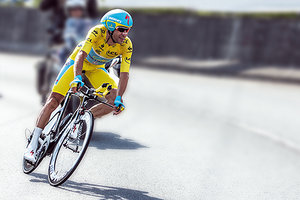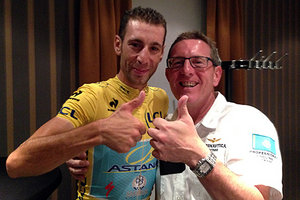When acupuncturist Eddy De Smedt pursued a career in Traditional Chinese Medicine, he knew he wanted to make a difference.
De Smedt joined The Astana team medical cohort as the main TCM specialist and worked alongside osteopaths and others to help the athletes perform at their top level. Nibali, the leader of the Astana team is only the sixth rider to win all three Grand Tours -- France, Italy and Spain. He was open to trying acupuncture with De Smedt to help him with recovery time among many other things and ended up loving it and using it to help his body before winning the race.
When Nibali took the stage in France to receive the honor of winning the Tour De France, De Smedt said he was beyond proud to have been part of such an amazing triumph. He spoke to Acupuncture Today about how he was able to help Nibali and other athletes and how his role as an acupuncturist abroad has evolved.
AT: Can you tell us about your acupuncture training, which took place in both China and Belgium?
 ES: First I was educated as a nurse. I wanted to know more about pain management and the mechanism behind it. So, I started to study acupuncture, which I did for four years in Belgium and in China. In Belgium, I went to the OTCG and ICZO, which is the most famous school. I also went two times to China to the University of Chinese medicine in Beijing where I was for six weeks or more for more practical training.
ES: First I was educated as a nurse. I wanted to know more about pain management and the mechanism behind it. So, I started to study acupuncture, which I did for four years in Belgium and in China. In Belgium, I went to the OTCG and ICZO, which is the most famous school. I also went two times to China to the University of Chinese medicine in Beijing where I was for six weeks or more for more practical training.
AT: How did you get involved with treating high profile athletes?
ES: I was already seeing patients in my practice over here in Belgium. I was seeing some tennis athletes, and some from motor cross and also some soccer players. Then I met Dr. De Maeseneer who was working with the professional team of Astana. He asked me to join the team Astana that must have been the end of 2012 and from that moment on I was the acupuncturist for the Astana team. I work for them 35-40 days per year basis.
AT: What are some of the advantages and challenges in treating athletes as opposed to regular patients?
ES: When we do our training camp I treat them as normal patients, I interrogate them for some energetic disturbances because in training camp there is a time to do a full screening which includes TCM when we are treating them in competition, there isn't any time for it so then we treat with some symptoms they have; if they are tired, have stomach problems or have aching muscles or joints. When I come in and recovery is the most important thing I am coming into action when they are getting tired, we try to improve recovery and relaxation and we focus on that kind of treatment.
 AT: What is your treatment plan like for competitive athletes?
AT: What is your treatment plan like for competitive athletes?
ES: In the Tour De France, everything is very scheduled and when you know the athletes better you know what you can do for them. They know we can do a lot for pain and also for recovery and relaxation. It depends on the each individual athlete and then you focus on their complaint, but on a regular basis with everyone we do a treatment before the race to improve performance and then we do a treatment late at night to promote recovery and to relax. In between, I treat complaints for stomach issues and issues with joints and joint pain.
AT: Tell us about working with the Tour De France team.
ES: That was great. I didn't realize when we joined Tour De France what we were doing. But, my main goal of my team, team Astana Pro was to win the Tour De France, so everything – the selection of the team – everything the whole goal was winning that. When you can do that, that is a great feeling, and being part of that even a small part, everyone is important the mechanics, the doctors, the cooks everyone is important. And winning the Tour De France was a great feeling.
AT: What special treatments did you provide the riders on the team?
ES: I have a protocol that is maybe one of the important things. The protocol is 10 needles which is relaxation for the whole body, that protocol they don't want to skip it every rider wants those needles after because they sleep well and they feel really relaxed and they kind of like it. So every night, the team was getting this protocol.
AT: What were some of the special needs that the team Astana had?
ES: When I started with the Astana Pro Cycling team, I talked with the entire medical team. My primary goal was to keep them in shape, enhance performance and recovery. If there was a pain complaint, the doctor would attend to it then the osteopath, then me. But sometimes the osteopath didn't have any results for pain and I did and vice versa so that depends on the medical briefing we had concerning the athletes on a daily basis.
AT: What was the feedback you got from some of the Tour De France cyclists?
ES: Most of them were not familiar with acupuncture, so I had to explain to them what acupuncture can do for them and I also made a report with acupuncture studies in it, with scientific proof that acupuncture can do this and do that. They were treated in January 2013 and experienced what acupuncture can do for them. In tour of Spain, which I was with them, they felt good and they told me they could sleep good. From then on they kept asking when I would be back on tour, so the feedback was positive.
AT: Can you tell us about treating Tour De France winner Vincenzo Nibali? Was he new to acupuncture?
ES: I met him first in April 2013, he was coming over from Italy to race here in Belgium. That was our first contact; he wasn't treated before by any acupuncturist. When I first treated him we had lots of talks about it and from that moment on, from the first treatment he was very, very positive and he also told the management that acupuncture treatments should continue. From that moment on when there was a race I was there also.
AT: Do you feel acupuncture played a major role in helping the team win?
ES: The team doctor, the riders – everyone was convinced that acupuncture can improve their treatment and even if its 2, 4, 5 percent for top athletes if you can make them better at the slightest level that is important.
AT: What are your plans at this point? Will you be working with other athletes?
ES: I am already proud to be part of a cycling team and now my goal is to focus on soccer players also, my son is a soccer player. They are different, there are different complaints, so I will focus on developing acupuncture protocols for these athletes, but I would like to make soccer players better in the future.
AT: Do you feel acupuncture now has a major role in sports medicine in Europe?
ES: I think because the acupuncture treatment that I gave Nibali was a hit in the press I am glad that acupuncture gets its position that it deserves within sports medicine, we are convinced we can do a lot maybe this is the first step to treating pro athletes on a regular basis.
AT: What advice would you give to acupuncturists interested in treating pro athletes?
ES: Good communication is very important. When my first patient a pro athlete came in I communicated with the main doctor what we can do. Known your place and what you do. The doctor can use a good briefing maybe a bit translated from Chinese medicine and the neurological and physical effects, once you can convince the doctors the rest will follow I think.



